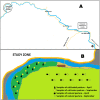Lead transfer in the soil-root-plant system in a highly contaminated Andean area
- PMID: 33505801
- PMCID: PMC7792523
- DOI: 10.7717/peerj.10624
Lead transfer in the soil-root-plant system in a highly contaminated Andean area
Abstract
Lead (Pb) is highly toxic heavy metal that is detrimental to the food system. There are large mining and metallurgical companies in the central highlands of Peru that have been active for almost a century and contribute to air, water, and soil pollution, affecting food quality and causing damage to the environment and human health. Our study, conducted in 2018, assessed the content and transfer of lead in the soil-root-plant system in the high Andean grasslands in a geographical area near the metallurgical complex of La Oroya. Lead levels were measured in 120 samples of top soil (0-20 cm), roots, and grass shoots by flame atomic absorption spectroscopy. No significant differences were found between the soil pH, organic matter content, and lead among the samples evaluated (P > 0.05). Mean Pb concentrations decreased in the order of soil > root > shoot (P < 0.01) (212.36 ± 38.40, 154.65 ± 52.85 and 19.71 ± 2.81 mg/kg, respectively). The soil-to-root Pb bioconcentration factor, root-to-shoot translocation factor, and soil-to-shoot bioaccumulation factor values were 0.74 ± 0.26, 0.14 ± 0.06 and 0.10 ± 0.03, respectively. Lead in the soil was 3.03 times higher than the maximum limit for agricultural soil, and was 1.97 times higher than the value limit for fodder. Our findings are important and show that soils and pasture in this geographical area have high Pb levels due to metallurgical emissions that have been occurring since 1922. Such pollution negatively impacts health and the socio-economic status of the exposed populations.
Keywords: Bioaccumulation factor; Contaminated soil; Forage quality; Heavy metals; Highland Andes Peru; Lead bioaccumulation; Lead in plans; Smelting; Soil pH.
©2021 Castro-Bedriñana et al.
Conflict of interest statement
The authors declare there are no competing interests.
Figures

Similar articles
-
Transfer of lead from soil to pasture grass and milk near a metallurgical complex in the Peruvian Andes.Transl Anim Sci. 2021 Jan 13;5(1):txab003. doi: 10.1093/tas/txab003. eCollection 2021 Jan. Transl Anim Sci. 2021. PMID: 34859197 Free PMC article.
-
Cadmium, copper, lead and zinc accumulation in wild plant species near a lead smelter.Ecotoxicol Environ Saf. 2020 Jul 15;198:110683. doi: 10.1016/j.ecoenv.2020.110683. Epub 2020 Apr 30. Ecotoxicol Environ Saf. 2020. PMID: 32361499
-
Accumulation of heavy metals in native Andean plants: potential tools for soil phytoremediation in Ancash (Peru).Environ Sci Pollut Res Int. 2018 Dec;25(34):33957-33966. doi: 10.1007/s11356-018-3325-z. Epub 2018 Oct 2. Environ Sci Pollut Res Int. 2018. PMID: 30280335
-
[Effects of Arbuscular Mycorrhizal Fungi on the Growth and Uptake of La and Pb by Maize Grown in La and Pb-Contaminated Soil].Huan Jing Ke Xue. 2017 Sep 8;38(9):3915-3926. doi: 10.13227/j.hjkx.201702041. Huan Jing Ke Xue. 2017. PMID: 29965275 Chinese.
-
A critical review of the bioavailability and impacts of heavy metals in municipal solid waste composts compared to sewage sludge.Environ Int. 2009 Jan;35(1):142-56. doi: 10.1016/j.envint.2008.06.009. Epub 2008 Aug 8. Environ Int. 2009. PMID: 18691760 Review.
Cited by
-
Assessing the Health Risk and Trophic Transfer of Lead and Cadmium in Dairy Farming Systems in the Mantaro Catchment, Central Andes of Peru.Toxics. 2024 Apr 24;12(5):308. doi: 10.3390/toxics12050308. Toxics. 2024. PMID: 38787087 Free PMC article.
-
Lead, Cadmium, and Arsenic in Edible Tissues of Guinea Pigs Raised in the Central Andes of Peru: Potential Human Health Risk?Vet Sci. 2025 Mar 21;12(4):292. doi: 10.3390/vetsci12040292. Vet Sci. 2025. PMID: 40284794 Free PMC article.
-
Lead and Cadmium Bioaccumulation in Fresh Cow's Milk in an Intermediate Area of the Central Andes of Peru and Risk to Human Health.Toxics. 2022 Jun 11;10(6):317. doi: 10.3390/toxics10060317. Toxics. 2022. PMID: 35736925 Free PMC article.
-
A cross-regional ecological assessment of contaminants in soils intended for agri-food initiatives on Indigenous Peoples' lands in Australia and Canada.Environ Monit Assess. 2024 Nov 25;196(12):1245. doi: 10.1007/s10661-024-13424-1. Environ Monit Assess. 2024. PMID: 39585519 Free PMC article.
-
Heavy Metal Bioaccumulation in Peruvian Food and Medicinal Products.Foods. 2024 Feb 29;13(5):762. doi: 10.3390/foods13050762. Foods. 2024. PMID: 38472875 Free PMC article. Review.
References
-
- Akinci IE, Akinci S, Yilmaz K. Response of tomato (Solanum lycopersicum L.) to lead toxicity: growth, element uptake, chlorophyll and water content. African Journal of Agricultural Research. 2010;5(6):416–423. doi: 10.5897/AJAR10.016. - DOI
-
- Alloway B. Heavy metals in soils: trace metals and metalloids in soils and their bioavailability. Environmental Pollution. 2013;22 doi: 10.1007/978-94-007-4470-7. - DOI
-
- Alvarez-Berríos N, Campos-Cerqueira M, Hernández-Serna A, AmandaDelgado JC, Román-Dañobeytia F. Impacts of small-scale gold mining on birds and anurans near the Tambopata Natural Reserve, Peru, assessed using passive acoustic monitoring. Tropical Conservation Science. 2016;9(2):832–851. doi: 10.1177/194008291600900216. - DOI
-
- Amari T, Ghnaya T, Abdelly C. Nickel, Cadmium and Lead phytotoxicity and potential of halophytic plants in heavy metal extraction. South African Journal of Botany. 2017;111(1):99–110. doi: 10.1016/j.sajb.2017.03.011. - DOI
LinkOut - more resources
Full Text Sources
Other Literature Sources

